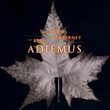| All Artists: Cornelis Dopper, Matthias Bamert, Residentie Orkest Title: Dopper: Symphonies Nos. 3 & 6 Members Wishing: 2 Total Copies: 0 Label: Chandos Release Date: 3/26/2002 Genre: Classical Style: Symphonies Number of Discs: 1 SwapaCD Credits: 1 UPC: 095115992326 |
Search - Cornelis Dopper, Matthias Bamert, Residentie Orkest :: Dopper: Symphonies Nos. 3 & 6
 | Cornelis Dopper, Matthias Bamert, Residentie Orkest Dopper: Symphonies Nos. 3 & 6 Genre: Classical
|
Larger Image |
CD DetailsSimilarly Requested CDs
|
CD ReviewsWho is Dopper? Russ | Richmond, VA | 07/15/2006 (5 out of 5 stars) "It is a shame when music is criticized for not being in touch with current musical trends. Yes, it is true that these twentieth century symphonies written by the Dutch composer Cornelis Dopper (1870-1939) aren't groundbreaking or revolutionary. They probably didn't influence future generations of composers across Europe, nor did they take the symphony to new heights. Yet, when examined from purely a musical perspective, these symphonies, to me, are outstanding. If it helps you enjoy these works more, please pretend that they were composed in 1850, but for me this isn't necessary.
Dopper really doesn't sound like any other composer, of which I am aware. But I would say this music was written by a composer who appreciates the good-natured earthiness of Dvorak, enjoys the use of the modal and pastoral colorings also implemented by Vaughan Williams, was familiar with French orchestral scoring and impressionist techniques, and who often gets lost in fairy-tale flights of fancy. If any of that sounds interesting to you, please get this disc. The two symphonies recorded here are cut from the same cloth. Each is a four movement work, featuring a lovely second movement and a bristling scherzo. Each symphony makes frequent use of Dutch folk music and dance tunes. As I mentioned earlier, these are not profound works in the Brucknerian sense. However, these aren't small works either. Dopper makes full use of orchestral palette. The sixth symphony for instance contains a prominent celesta part, which appears above what I believe to be a contra bass bassoon in one section. As another example, the third movement of the third symphony (Track 2) contains an ethereal melody in which a descending bassoon passage is accompanied by rising violins and a twinkling harp. This characteristic use of orchestral color, particularly the flutes and double reads, is what makes Dopper's music so much more distinctive than that of other lesser known late Romantics, such as Raff. This music is not "light" in terms of dynamics either. The imposing second section of the sixth symphony's adagio (Track 6), culminating with an organ blast, is really one to crank up the volume on. Likewise, the powerful scherzo of that symphony (Track 7), with its pounding drums and dominating horn playing, will certainly leave you wondering why this music isn't better known. With that said, Dopper's themes themselves are not meant to be earth shattering. From that perspective, Dopper's endings, which include fanfaring brass and pounding timpani, may seem to be overly dramatic and just a little out of place, but, I think that's all part of the fun here. If you have a grumpy temperament, take yourself too seriously or believe that any deviation from the German symphonic model is a bad idea, you probably want to skip this disc. For everyone else, I fully recommend this charming, tuneful release. On a side note, this is the second volume of Dopper symphonies released by these forces. The first volume features the second symphony, and is equally as appealing. Unfortunately, things have been cold and dark on the Dopper front, after the release of this CD in early 2002. I really hope that Chandos continues the cause and puts the remaining four symphonies to disc. 60:12" |

 Track Listings (8) - Disc #1
Track Listings (8) - Disc #1








